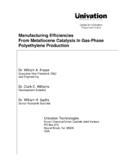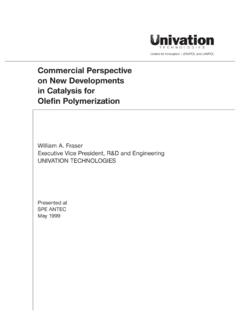Transcription of Polyethylene Product Capabilities From Metallocene ...
1 1Dr. J. LaMonte AdamsSenior EngineerDr. David M. SimpsonProject ScientistPolyethylene Product CapabilitiesFrom Metallocene Catalysts with theUNIPOL ProcessDr. William A. FraserExecutive Vice President, R&D and Engineering Univation TechnologiesExxon Chemical/Union Carbide Joint VenturePO Box 670 Bound Brook, NJ 08805 USA2 ABSTRACTM etallocene catalysts developed and provenin the UNIPOL gas-phase PE Process comprisea platform technology for creating new families ofimproved polyethylenes for volume PE which will win in the diverse and frag-mented volume film markets of Asia/Pacific mustbe especially versatile in their ability to be proc-essed on a wide range of fabrication technology has been used withthe UNIPOL Process to demonstrate a range ofmPEs with narrow to broad molecular weight dis-tribution, narrow comonomer distribution, and lin-ear to long chain branched structures.
2 Prototype,improved processing mPEs for blown film appli-cations span a wide performance domainof processability and properties. Developmentalproducts are described which target the process-ability regime of LDPE/LLDPE blends, areuseable on both LLDPE and LDPE equipment,and deliver improvements in film capability has also been demonstratedto produce mPEs gas phase with rheology essen-tially matching that of Polyethylene industry is a technology inten-sive industry undergoing a period of major tech-nology renewal. High intensity R&D investmentdriving this technology renewal extends acrossa range of technology fronts: catalysis, processengineering, Product development, and end-useapplications extensions. Some of this technologyrenewal, principally in the domain of catalysis( Metallocene chemistry), has the potential to be-come revolutionary in scope and impact.
3 Certainvery significant technical advances, principallyin the area of process/reaction engineering, rep-resent major evolutionary technical Metallocene catalyst technology,leveraged with these evolutionary advances, ex-tensions and refinements of Polyethylene manu-facturing engineering, is now entering mainstreamcommercial development in the volume PE mar-ketplace. This paper discusses how metallocenecatalyst technology and new gas-phase proc-ess/reaction technology developments intersectwith the Polyethylene industry of the BASEDPOLYETHYLENE (mPE) FORASIA/ PACIFIC MARKETSP olyethylene demand growth in Asia/Pacific is robust, projected to continue at ratessignificantly above GDP growth. PE capacitybuildup in the region will add more than 3million TPY of new production by 2000, an in-crease of more than 30%.
4 (1) New investment willbring new catalysis is a rich and fertiletechnology, with major implications for thePE industry. It is a very broad technology. Themost widely discussed aspect of this technologyPOLYETHYLENE Product CAPABILITIESPOLYETHYLENE Product Capabilities FROMMETALLOCENE CATALYSTS WITH THE UNIPOL PROCESSDr. William A. Fraser, Dr. J. LaMonte Adams, Dr. David M. SimpsonUnivation TechnologiesExxon Chemical/Union Carbide Joint Venture 1997 Univation TechnologiesUNIPOL is a registered trademark of Union CarbideEXXPOL is a registered trademark of Exxon Corporation3advance has been the development of new PEproducts with major improvements in propertiesand end-use performance. Many conferencepapers have described the Capabilities of thischemistry to control with high precision the struc-ture and properties of new Product families of PEmaterials tailored to very specific catalysis represents a tool for PEproduct development, a capability to engineerpolymer structure at the molecular level.
5 Thereare things this tool can do that other catalystsystems some of the emerging growth marketsof the Asia/Pacific region, there exists a potentialPE marketing paradox. The technology renewalunderway in Metallocene catalysis and PE poly-mer manufacturing capability appears to be in col-lision with a fragmented, diverse downstreammarketplace not yet ready to make full use of, letalone take full advantage of, the high performancespecialized Capabilities of Metallocene catalyzedPE products. To the contrary, molecular engi-neering capability embodied in Metallocene tech-nology can be applied to produce PE resins withproperty characteristics balanced to adapt to thebroad functionality demands of the wide rangingAsia/Pacific mPE FOR VOLUMEAPPLICATIONSU nion Carbide and Exxon Chemical haveformed a 50/50 joint venture to develop, market ,and license advanced production process andcatalyst technologies for the manufacture ofperformance and economically advantagedpolyethylenes.
6 The joint venture, UnivationTechnologies, combines EXXPOL metallocenecatalyst systems and capacity-enhancing SuperCondensed Mode Technology (SCM-T) with theUNIPOL gas-phase PE process to acceleratethe pace and broaden the global reach of metallo-cene technology applied to volume PE technology encompasses thefirst Metallocene systems commercialized forgas-phase PE manufacture and also includescomplementary UCC Metallocene systems dev-eloped for UNIPOL. SCM-T is a commerciallydemonstrated technology that can enable UNIPOL licensees to expand production capacity at invest-ment costs significantly lower than that for newconstruction. UNIPOL PE process technologycombines the lowest capital and operating costswith the broadest conventional catalyst productrange of any PE new company brings together world-class R&D Capabilities and consolidates the mo-mentum of major research efforts to create thebest technology program in the industry devoted tometallocene chemistry applied to gas-phasePE production.
7 Univation Technologies is a tech-nology and licensing company committed to driv-ing technology renewal in the Polyethylene indus-try and keeping state-of-the-art a moving believe that few segments of the PEindustry and no region of the world will be un-touched by the Metallocene technology advancesnow moving from a specialty niche applicationsfocus into the core of volume PE production andthe arena of commodity markets and , SCM-T, and UNIPOL are proventechnologies which will provide licensees of Uni-vation the Capabilities to capture new business andstay ahead in the expanding marketsof the Asia/Pacific DEMAND GROWTH-WORLDWIDE AND IN ASIA/PACIFICP olyethylene is an enormously versatilematerial, serving a very broad array of marketsand end uses. This Product versatility derivesfrom:(1) the very attractive intrinsic character- istics of hydrocarbon polymers; toughness, durability, chemical inert- ness, environmental cleanliness, dielectric strength, etc.
8 (2) the wide range of molecular structuresinherent to Polyethylene Polyethylene Product CAPABILITIES4 (3) the development of efficient reliablemanufacturing processes for producingPE polymers at low cost (4) refined Capabilities to manipulate poly-mer structure and, in turn, theperformance-in-use of PE productsIn combination, these four elements continueto drive demand growth for this mostversatile polymer. The technology elements,(3) and (4), have been fuel for this demand growth for polyethylenecontinues at ~6%/yr, building from a base whichreached 40 million metric tons in 1996. That proj-ects to more than 50 million metric tons of PEdemand early in the next decade. WorldwideLLDPE demand growth is forecast (1995-2000)to average ~13%/yr, with consumption reaching~14 million metric tons in 2000.
9 (1)Chem Systems projects (1995-2000) totalPE consumption in the Asia/Pacific region(ex Japan) to average ~ 9%/yr, growing from abase demand of ~10 million metric tons in demand growth in this region is expectedto approach 18% reaching ~4 million metric tonsin 2000.(1)Figure 1 plots projected demand growth forvarious the period to 2000, LDPE demand willshow zero growth. By 2000, LLDPE penetrationof the total LD plus LL market is projected byChem Systems to reach 48% worldwide and58% in Asia/Pacific (ex Japan).(1)Figure 2 shows six major end-use marketsfor Polyethylene , accounting for more than 85%of total PE consumption. Film applicationsrepresent the largest volume end-use.(2)Figure 3 shows the major end-use marketsfor LDPE and LLDPE. Film applications repre-sent nearly 70% of the global demand for theseresins.
10 (1)Figure 1. Polyethylene DEMAND BY RESIN TYPE (GLOBAL AND ASIA/PACIFIC)050001000015000200002500019 9019911992199319941995199619971998199920 00 Demand (kta)Global HDPEG lobal LDPEG lobal LLDPEAsia/Pacific HDPEAsia/Pacific LLDPEAsia/Pacific LDPES ource: CHEM SYSTEMSYearFigure 2. MAJOR END-USE APPLICATIONS FOR POLYETHYLENEAllOther14%Wire & Cable 2%Pipe & Conduit 4%Extrusion Coating 4%Source: SRI InternationalBlowMolding14%Film &Sheet 48% 3. LDPE + LLDPE DEMAND BY END-USE APPLICATIONO ther 5%Other Extrusion 7%Rotomolding 2%Extrusion Coating 7%Injection Molding 8%Blow Molding 2%Film 69%Source: CHEM SYSTEMSPOLYETHYLENE Product CAPABILITIES5 UNIPOL PE PRODUCTION CAPACITY-WORLDWIDE AND IN ASIA/PACIFICThe UNIPOL Process for PE manufac-ture is used around the world by Union Carbide,its Joint Ventures, and licensees in 68 reactorlines.





